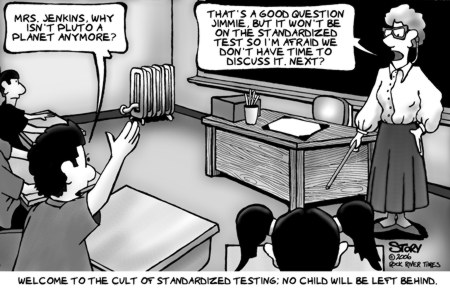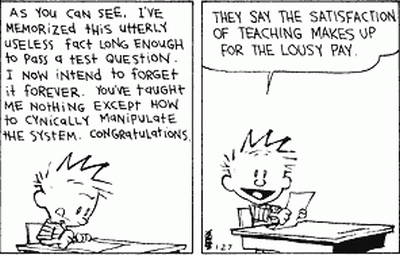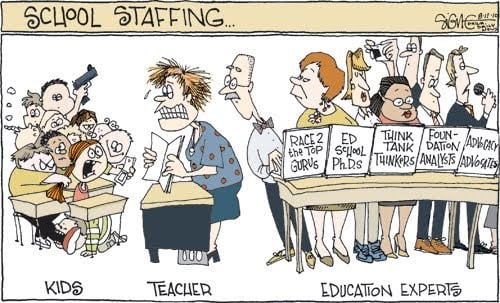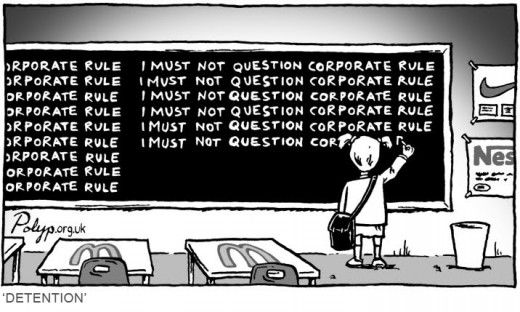Chasing Literacy: The Construction of the Standardized Test and the American Struggle to Catch up with Literacy.

No Child Left Behind, in Brief
In 2001, President George W. Bush pushed and passed a law that would consequently devastate the United States public education system. The law stated that by 2014, every child will be at grade level in reading and math, meaning our children and students would be reading with 100% proficiency based on grade level. The law was known as No Child Left Behind (NCLB). It sounds great, doesn’t it? It seems every parent and teacher’s utopian dream that no child gets left behind in a system that values education as a free right. Unfortunately, there are many things fundamentally wrong with NCLB that have served to increase the achievement gap.

The Problems with Standardized Testing
A key factor in NCLB is the standardized test, the primary source of assessment for students AND teachers, AND schools. Schools receive funding and resources based on this test taken every year by the students.
There are many types of student assessment from informal to formal, paper/pencil to performance assessments, traditional and authentic assessments, and criterion referenced verse norm referenced (what I want to highlight today). While criterion referenced assessments evaluate students based on their level of mastery, norm referenced assessments measure performance relative to peers, and provide no individual feedback to students or parents regarding performance. This is the type of assessment by which NCLB has based its test practices.
Additionally, teachers are to blame for poor scores, despite the increasingly large bureaucracy coming from district, state, and national levels which places so many restrictions on what must and must not happen in the classroom, making it nearly impossible for teachers to do the job they were hired to do – teach, and often putting their jobs in jeopardy.
I have recently learned some interesting facts about standardized testing and will take the liberty to share them with you.

Standardized tests are carefully constructed by a committee in such a way as to maintain a 50/50 bell curve. This means there will be those students who fall above average, and there will be those students who will fall below average. In other words, about fifty percent of students nationwide will actually meet the proficiency standards while the other fifty percent of students will fall below proficiency.
It’s not surprising that after a few years of testing, students begin to figure out the test and beat the system. But don’t be fooled! The test-makers are not unaware of this! About every three years, right about the time when students have figured out the test, and analysts begin noticing that an increased number of students are meeting proficiency, the committee will then recalibrate the test in such a way that fifty percent will once again not meet proficiency. In short, these tests are purposely constructed so that half of all students taking them will fail. And yet, these tests will determine a school’s funding, and even worse, a teacher’s performance in the classroom, and possibly that teacher’s job!

Most people will find this information shocking, as did I when it first came to me. I mean, don’t we all believe that when a policy is implemented stating that by 2014, our students will be reading with 100% proficiency based on grade level, our leaders will do everything possible to make sure that happens? Our students are supposed to be improving! Yet, the test provides no way for our students to achieve the standard!
Seems so unfair to students and teachers, and even schools, doesn’t it? How can students get ahead if they are required to take a test every year that they are expected to fail at? How can teachers keep their jobs when they work at a low performing school that is expected to fall below proficiency? And how can that school receive the necessary funding and resources to teach affectively when it is expected to fail? Not only are these students, teachers, and schools expected to fail, but also the mysterious force making the decisions is not providing a way for students to get ahead!
In reality, the Bush administration created a system in which the schools that need the MOST HELP are essentially left behind, while the schools that need LITTLE to NO HELP are getting all the benefits.

Performance: From Student to Teacher
From a student’s perspective: “If I’m not getting graded on this, than what good is it to me? Why should I be motivated to do well on this test?” Is it any wonder many students answer with a B or a C all the way down the scantron? Even if these tests were measured based on mastery rather than performance relative to peers, and even if the tests weren't scored to fit a desired result, the standards for proficiency continue to increase. Altogether, these tests make it impossible for students to achieve at grade level, making the chase to catch up to literacy a never-ending, losing battle.
And as for the teachers, you might initially argue that there are too many bad teachers who should be fired anyhow, and the test scores are just one way to locate who those teachers are. Wrong! Ken Goodman writes in his book titled, In Defense of Good Teaching, “A lesson that those mandating curriculum and methodology have not understood is that only teachers can change what happens in classrooms…The most dedicated, hardest working, and best informed teachers are being blamed for the failures of a system being continuously eroded by politicians.” While there are bad teachers in the public school system, there are more good teachers than there are bad, and the good ones are loosing their jobs or leaving the field of education altogether at an increasingly high rate. According to Diane Ravitch, long time historian of education and author of the book The Death and Life of the Great American School System: How Testing and Choice Are Undermining Education, “Fifty percent of all those who enter teaching leave within the first five years. Our biggest problem is not getting rid of deadbeats, but recruiting, retaining, and supporting teachers.” There are many reasons why so many teachers are leaving; one major reason is the lack of support, resources, tools, supplies and training needed to teach effectively.


Articles of Interest & Additional Information
In talking with some educators, I have found there are many varying opinions as to why public education is so increasingly scrutinized. Many like-minded teachers I know believe there is a great deal of corporate interest underlying the failure of public schools. With the rise of private, charter, and magnet schools, we are beginning to see a top-down organizational structure, privatization, and competition in the American school system that will serve only to keep the top performers (generally those from an elite, upper-middle, and middle class socio/economic background) ahead and push the low performers (generally those from a lower-middle class and poor socio/economic background) down, inevitably increasing the achievement gap when the goal is to close it. For more information on corporate education interests and the privatization of schools in America, on why standardized tests are problematic, or for information on NCLB, follow the links below.
Corporate Education Interests and the Privatization of Schools:
http://www.educationanddemocracy.org/Resources/Gordon.htm
http://parentsacrossamerica.org/2011/03/parents-across-america-on-corporate-interests-in-education/
http://www.leftturn.org/corporate-hijacking-public-education
The Problems with Standardized Testing:
http://www.education.com/reference/article/Ref_Test_Problems_Seven/?page=2
No Child Left Behind:



